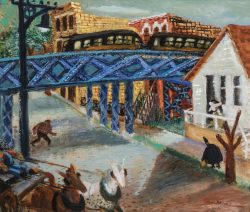Aaron Bohrod 1907–1992
The son of a Jewish immigrant grocer from Bessarabia (a region now divided between Moldova and Ukraine), Chicago native Aaron Bohrod observed late in life that “All I’ve ever really wanted to do is paint.”i After graduating from Crane Technical High School, in 1927 he enrolled at the Art Institute of Chicago and began working as a commercial artist. He then attended the Art Students League in New York, from 1930 to 1932. Among his most influential teachers was Ashcan School artist John Sloan, who inspired Bohrod to embrace the vitality of modern life in his art. Returning to Chicago, Bohrod began successfully exhibiting colorful watercolor and oil paintings and prints of urban scenes as he became active in the city’s progressive art circles. His favorite subjects were street views from his own North Side neighborhood, one of which won the first of Bohrod’s many prizes when it was shown in the Art Institute’s annual “Chicago and Vicinity” exhibition in 1933. The following year, the Whitney Museum in New York purchased one of his watercolors.
Despite the dire conditions for artists during the Great Depression, Bohrod was able to support himself as a full-time artist, but he also received mural commissions through the Federal Art Project, an artists’ relief program. Beginning in 1936, two consecutive Guggenheim Fellowships enabled the artist to travel widely in the U.S., giving him material for the rural subjects favored by the so-called American Scene painters of the period. By that point, Bohrod had abandoned the loose technique and playful color of his early city scenes for a more controlled, restrained approach and what one writer described as “deep, rich, Rembrandtesque hues,” heralding the style of his later still life paintings.ii
Bohrod reached a wide audience through his affiliation with Associated American Artists, a New York gallery that marketed art to middle-class consumers. He was appointed a visiting artist at Southern Illinois University in Carbondale in 1941, but when the U.S. entered World War II soon afterward he left to take an assignment with Life magazine: working on both the European and Pacific fronts, he documented the horrors of war in paintings. Between 1948 and his retirement in 1973, Bohrod served as artist-in-residence at the University of Wisconsin at Madison. There he took up pottery, eventually writing a book on the subject. Bohrod was elected to the National Academy of Design in 1953. The following year, he gave up painting landscapes to concentrate on trompe-l’oeil (fool-the-eye) still-life imagery, using an exaggeratedly detailed realism to infuse arrangements of damaged or discarded objects and printed images with an aura of surrealist fantasy. The success Bohrod enjoyed throughout his career as a fine artist continued into his last years, during which he was the subject of numerous exhibitions.
Wendy Greenhouse, PhD
i Patricia Raymer, “Aaron Bohrod,” Milwaukee Journal, circa 1973, undated clipping in Aaron Bohrod file, Chicago Artists Archive, Harold Washington Library Center, Chicago Public Library.
ii Edith Weigle, “The Art of Aaron Bohrod,” Chicago Sunday Tribune Magazine, Sept. 16, 1962: 14.
